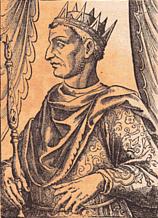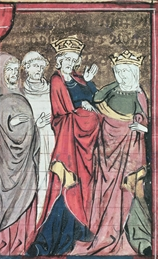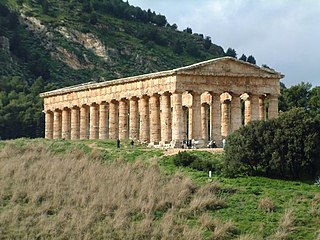Related Research Articles

Year 1166 (MCLXVI) was a common year starting on Saturday of the Julian calendar.

Year 1091 (MXCI) was a common year starting on Wednesday of the Julian calendar.

Monreale is a town and comune in the Metropolitan City of Palermo, in Sicily, Southern Italy. It is located on the slope of Monte Caputo, overlooking the very fertile valley called "La Conca d'oro", a production area of orange, olive and almond trees, the produce of which is exported in large quantities. The town, which has a population of approximately 39,000, is about 7 kilometres inland (south) of Palermo, the regional capital.

Roger II or Roger the Great was King of Sicily and Africa, son of Roger I of Sicily and successor to his brother Simon. He began his rule as Count of Sicily in 1105, became Duke of Apulia and Calabria in 1127, then King of Sicily in 1130 and King of Africa in 1148.

Tancred was King of Sicily from 1189 to 1194. He was born in Lecce, an illegitimate son of Roger III, Duke of Apulia by his mistress Emma, a daughter of Achard II, Count of Lecce. He inherited the title "Count of Lecce" from his grandfather and is consequently often referred to as Tancred of Lecce. Due to his short stature and unhandsome visage, he was mocked by his critics as "The Monkey King".

William I, called the Bad or the Wicked, was the second king of Sicily, ruling from his father's death in 1154 to his own in 1166. He was the fourth son of Roger II and Elvira of Castile.

William II, called the Good, was king of Sicily from 1166 to 1189. From surviving sources William's character is indistinct. Lacking in military enterprise, secluded and pleasure-loving, he seldom emerged from his palace life at Palermo. Yet his reign is marked by an ambitious foreign policy and a vigorous diplomacy. Champion of the papacy and in secret league with the Lombard cities, he was able to defy the common enemy, Frederick Barbarossa. In the Divine Comedy, Dante places William II in Paradise. He is also referred to in Boccaccio's Decameron.

Constance I was the Queen of Sicily from 1194 until her death and Holy Roman Empress from 1191 to 1197 as the wife of Emperor Henry VI.

William III, a scion of the Hauteville dynasty, was the last Norman King of Sicily, who reigned briefly for ten months in 1194. He was overthrown by his great-aunt Constance and her husband Emperor Henry VI.

The Kingdom of Sicily was a state that existed in Sicily and the south of the Italian Peninsula plus, for a time, in Northern Africa from its founding by Roger II of Sicily in 1130 until 1816. It was a successor state of the County of Sicily, which had been founded in 1071 during the Norman conquest of the southern peninsula. The island was divided into three regions: Val di Mazara, Val Demone and Val di Noto.

Adelaide del Vasto was countess of Sicily as the third spouse of Roger I of Sicily, and Queen consort of Jerusalem by marriage to Baldwin I of Jerusalem. She served as regent of Sicily during the minority of her son Roger II of Sicily from 1101 until 1112.

The House of Hauteville was a Norman family, originally of petty lords, from the Cotentin Peninsula in Normandy.

The history of Sicily has been influenced by numerous ethnic groups. It has seen Sicily controlled by powers, including Phoenician and Carthaginian, Greek, Roman, Vandal and Ostrogoth, Byzantine, Arab, Norman, Aragonese, Spanish, Austrians, British, but also experiencing important periods of independence, as under the indigenous Sicanians, Elymians, Sicels, the Greek-Siceliotes, and later as County of Sicily, and Kingdom of Sicily. The Kingdom was founded in 1130 by Roger II, belonging to the Siculo-Norman family of Hauteville. During this period, Sicily was prosperous and politically powerful, becoming one of the wealthiest states in all of Europe. As a result of the dynastic succession, the Kingdom passed into the hands of the Hohenstaufen. At the end of the 13th century, with the War of the Sicilian Vespers between the crowns of Anjou and Aragon, the island passed to the latter. In the following centuries the Kingdom entered into the personal union with the Spaniard and Bourbon crowns, while preserving effective independence until 1816. Sicily was merged with the Kingdom of Italy in 1861. Although today an Autonomous Region, with special statute, of the Republic of Italy, it has its own distinct culture.

The Italo-Normans, or Siculo-Normans (Siculo-Normanni) when referring to Sicily and Southern Italy, are the Italian-born descendants of the first Norman conquerors to travel to Southern Italy in the first half of the eleventh century. While maintaining much of their distinctly Norman piety and customs of war, they were shaped by the diversity of Southern Italy, by the cultures and customs of the Greeks, Lombards, and Arabs in Sicily.

The Norman conquest of southern Italy lasted from 999 to 1194, involving many battles and independent conquerors.

The Byzantine–Norman wars were a series of military conflicts between the Normans and the Byzantine Empire fought from c. 1040 to 1186 involving the Norman-led Kingdom of Sicily in the west, and the Principality of Antioch in the Levant. The last of the Norman invasions, though having incurred disaster upon the Romans by sacking Thessalonica in 1185, was eventually driven out and vanquished by 1186.

The term Norman–Arab–Byzantine culture, Norman–Sicilian culture or, less inclusively, Norman–Arab culture, refers to the interaction of the Norman, Byzantine Greek, Latin, and Arab cultures following the Norman conquest of the former Emirate of Sicily and North Africa from 1061 to around 1250. The civilization resulted from numerous exchanges in the cultural and scientific fields, based on the tolerance shown by the Normans towards the Latin- and Greek-speaking Christian populations and the former Arab Muslim settlers. As a result, Sicily under the Normans became a crossroad for the interaction between the Norman and Latin Catholic, Byzantine–Orthodox, and Arab–Islamic cultures.

The Normans were a population arising in the medieval Duchy of Normandy from the intermingling between Norse Viking settlers and locals of West Francia. The Norse settlements in West Francia followed a series of raids on the French northern coast mainly from what is now Denmark, although some also sailed from Norway and Sweden. These settlements were finally legitimized when Rollo, a Scandinavian Viking leader, agreed to swear fealty to King Charles III of West Francia following the siege of Chartres in 911. The intermixing in Normandy produced an ethnic and cultural "Norman" identity in the first half of the 10th century, an identity which continued to evolve over the centuries. The Normans adopted the culture and language of the French, while they continued the martial tradition of their Viking ancestors as mercenaries and adventurers. In the 11th century, Normans from the duchy conquered England and southern Italy.

The County of Apulia and Calabria, later the Duchy of Apulia and Calabria, was a Norman state founded by William of Hauteville in 1043, composed of the territories of Gargano, Capitanata, Apulia, Vulture, and most of Campania. It became a duchy when Robert Guiscard was raised to the rank of duke by Pope Nicholas II in 1059.
References
- ↑ Birk, Joshua C. (2017). Norman Kings of Sicily and the Rise of the Anti-Islamic Critique: Baptized Sultans. Springer. p. 266. ISBN 9783319470429.
- ↑ "William II | king of Sicily". Encyclopedia Britannica. Retrieved 15 January 2019.